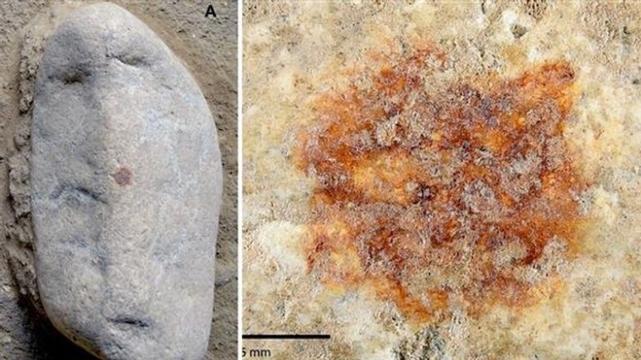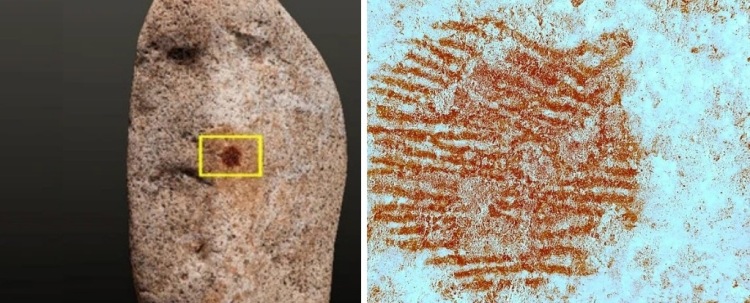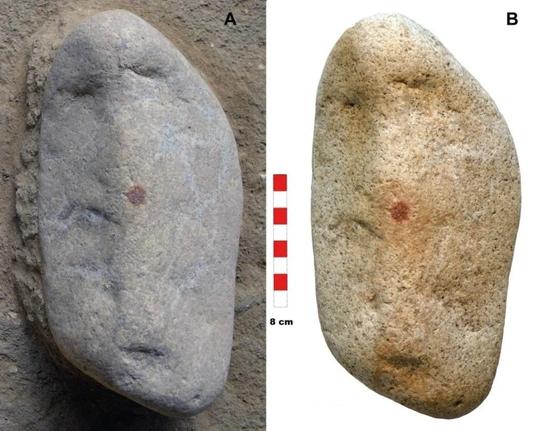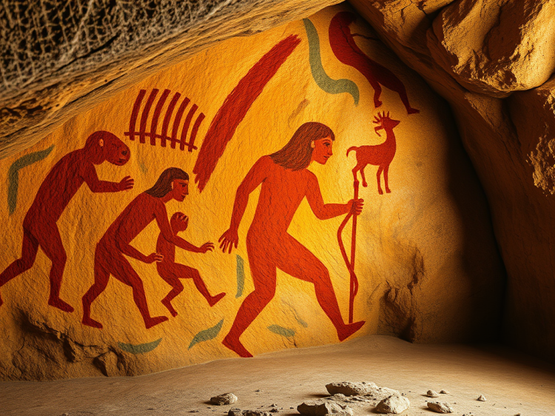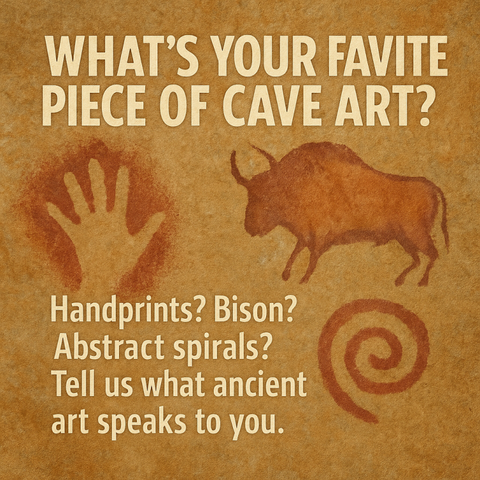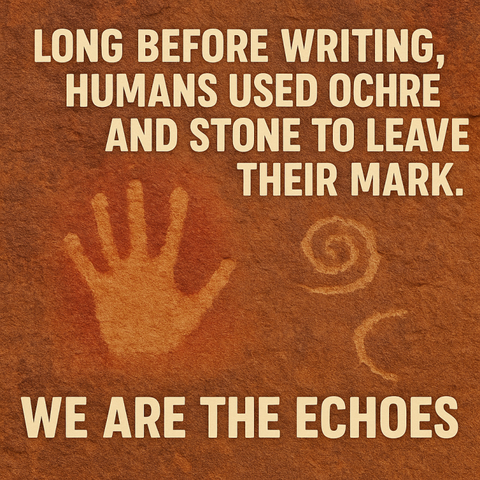A Touch Across Time: The Neanderthal Fingerprint That Changed Everything
In the quiet, sun-dappled hills of San Lázaro, Spain, archaeologists recently stumbled upon an astonishing discovery—a simple red ocher fingerprint pressed deliberately onto a rock surface some 43,000 years ago. At first glance, this may seem humble: a fleeting human mark from deep history. But this fingerprint is far more profound. It belongs not to Homo sapiens—modern humans like you and me—but to our enigmatic cousins, the Neanderthals (Rodríguez-Hidalgo et al., 2024).
This tiny imprint is more than just an ancient mark. It’s a tangible, intimate connection to a Neanderthal individual, someone who stood exactly where researchers now stand, touching a stone in a purposeful act. So, what exactly does this discovery mean for our understanding of Neanderthals? Why is it so exciting, and why should it captivate us?
A Moment Captured in Time
Consider, for a moment, the sheer wonder of a fingerprint. Every single ridge and swirl is unique to an individual—a personal signature no one else shares. This particular Neanderthal fingerprint, vividly preserved in red ocher, offers an intimate snapshot from tens of thousands of years ago. The decision to press one’s finger onto the rock, leaving a deliberate mark, strongly suggests intentionality and symbolic expression (Zilhão, 2012).
Previously, many viewed Neanderthals as primarily practical, survival-focused beings who didn’t engage significantly in symbolic thought. Over recent decades, however, discoveries like shell jewelry, cave art, and now this fingerprint have profoundly reshaped that narrative. This fingerprint suggests a conscious, meaningful action—a symbolic gesture that hints at complex thought processes and an awareness of self and identity (d’Errico & Stringer, 2011).
Symbolism and Self-Awareness
When modern humans use art, we communicate ideas, emotions, or stories. Could the same be true for Neanderthals? The placement of the fingerprint wasn’t random; the stone was naturally shaped somewhat like a face. By enhancing its facial features with this print, the Neanderthal artist was engaging in representational thought, transforming a naturally occurring shape into something more—a representation with meaning beyond mere practicality.
This find challenges earlier assumptions about Neanderthal cognition, pushing the boundary of what we define as distinctly “human.” Symbolic behavior and self-awareness have often been considered hallmarks of modern human cognition. Finding evidence of this behavior in Neanderthals suggests that they shared far more cognitive and cultural complexity with us than previously thought (Hovers & Belfer-Cohen, 2013).
What We’ve Learned So Far
This single fingerprint can tell us a surprising amount. Forensic analysis has determined that it belonged to an adult male, offering a glimpse into the demographics of the site (Rodríguez-Hidalgo et al., 2024). Its remarkable preservation provides clues about Neanderthal material culture. Ocher, a naturally occurring mineral pigment, was clearly valued, collected, and used deliberately.
Studies of ocher use among both modern humans and Neanderthals show it was often employed in rituals, personal adornment, and symbolic contexts. Its presence on this stone strongly supports the interpretation of symbolic intent rather than mere practicality (Wadley, 2005).
New Avenues of Research
Where do we go from here? First, archaeologists can explore other Paleolithic sites with fresh eyes, looking for subtle symbolic marks or impressions previously overlooked. Discoveries like this fingerprint remind us that symbols and meaning-making activities may not always be grandiose. Sometimes, they’re understated yet powerful.
Second, interdisciplinary collaboration is crucial. Forensic science, pigment analysis, cognitive archaeology, and ethnography must come together to illuminate the broader context of such symbolic acts. Was this mark part of a social ritual or a personal statement? Did ocher carry particular cultural significance?
Third, this discovery encourages us to re-evaluate the archaeological record holistically. Perhaps other seemingly mundane artifacts conceal symbolic dimensions. Staying open to subtle details might reveal hidden narratives and richer cognitive worlds.
Implications for Science and Humanity
Archaeology thrives on asking better questions. Once, the core question about Neanderthals was whether they had symbolic capacity at all. Now, the focus shifts: What form did their symbolic behavior take? How widespread was it? What role did symbolism play in their social fabric?
This find also highlights the importance of site preservation and meticulous excavation. The fingerprint survived thanks to extraordinary preservation conditions—conditions increasingly threatened by climate change and human activity.
Importantly, this discovery prompts us to rethink human uniqueness. If symbolic expression developed independently in different hominin species, then symbolism may not be a rare cognitive anomaly but a fundamental aspect of hominin brain evolution. This challenges longstanding assumptions about our exclusive grip on culture and art.
Bridging the Millennia
Perhaps the most compelling aspect of this discovery is its intimacy. A fingerprint bridges tens of thousands of years, connecting two individuals across an unimaginable gulf of time. It evokes empathy, curiosity, and awe. We glimpse, however briefly, the emotional and intellectual world of a person long gone.
The emerging picture of Neanderthals is one of nuance and richness. They were not brutish outliers of evolution but thoughtful, creative beings with lives filled with meaning. This fingerprint deepens that narrative and elevates our appreciation for the breadth of human experience.
Final Reflections
The red ocher fingerprint from San Lázaro is a potent reminder that history is made not only through tools and bones but through the quiet, deliberate gestures of individuals. This ancient mark redefines what it means to be human and extends our story beyond the borders of Homo sapiens.
As scientific inquiry continues, each new discovery—no matter how small—adds to our collective understanding. The fingerprint from San Lázaro is a vivid testament that every one of us leaves an impression. Some fade. Some, like this, endure.
Let it inspire us to keep asking questions, stay curious, and embrace the deep history that connects us all.
References:
d’Errico, F., & Stringer, C. (2011). Evolution, revolution or saltation scenario for the emergence of modern cultures? Philosophical Transactions of the Royal Society B: Biological Sciences, 366(1567), 1060–1069. https://doi.org/10.1098/rstb.2010.0303
Hovers, E., & Belfer-Cohen, A. (2013). On variability and complexity: Lessons from the Levantine Middle Paleolithic record. Current Anthropology, 54(S8), S337–S357. https://doi.org/10.1086/673389
Rodríguez-Hidalgo, A., et al. (2024). Neanderthal fingerprint on ochre-enhanced stone at San Lázaro, Spain: Symbolic behavior in the Middle Paleolithic. Archaeological and Anthropological Sciences, 16(2). https://doi.org/10.1007/s12520-024-01876-2
Wadley, L. (2005). Putting ochre to the test: Replication studies of adhesives that may have been used for hafting tools in the Middle Stone Age. Journal of Human Evolution, 49(5), 587–601. https://doi.org/10.1016/j.jhevol.2005.06.007
Zilhão, J. (2012). Personal ornaments and symbolism among the Neanderthals. In J.-J. Hublin & M. P. Richards (Eds.), The Evolution of Hominin Diets (pp. 35–49). Springer.
#AncientMind #AnthropologyMatters #Archaeology #CaveArt #CognitiveEvolution #DeepHistory #EarlyHumans #HomininCulture #HumanOrigins #Imagination #Neanderthal #NeanderthalArt #Paleoanthropology #Paleolithic #PaleoPost #PaleoPostDeepHistoryNeanderthalArtCaveArtAnthropologyMattersScienceCommunicationHomininCultureCognitiveEvolutionPrehistoricExpression #PrehistoricArt #RockArt #ScienceCommunication #SymbolicArt #earlyHumans #evolution #genetics #history #Science
